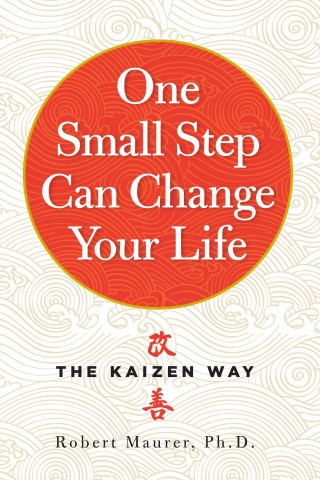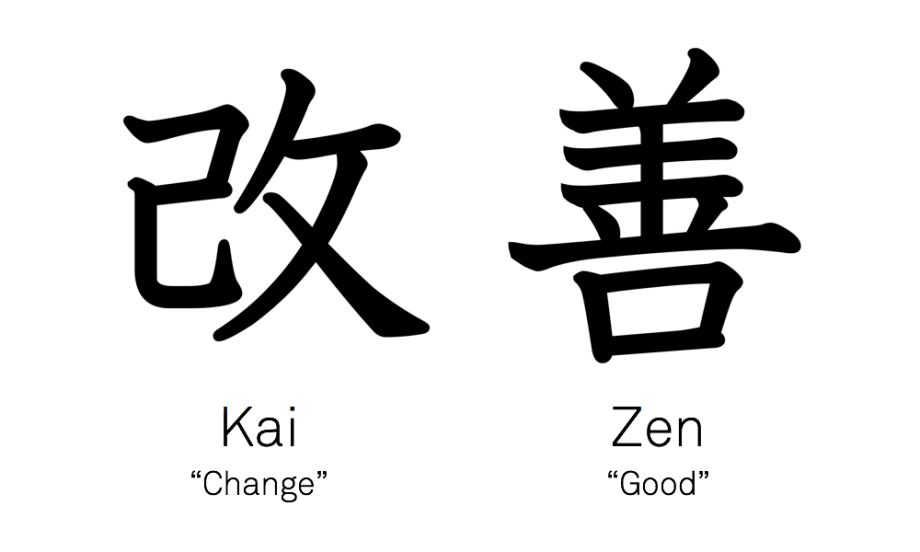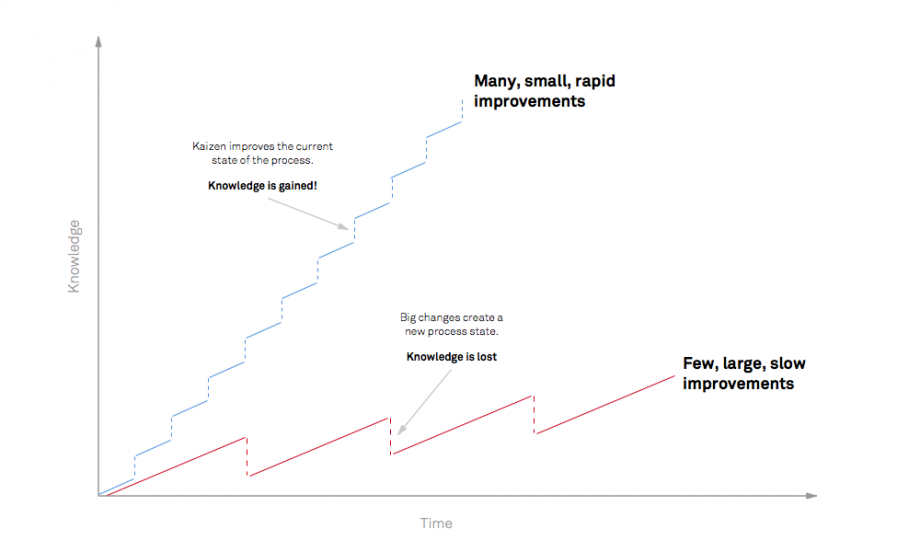I took a short trip to Barcelona recently, and whilst that is of no significance to this post, it did give me time to relax, reflect AND read a book.
The book is called “One Small Step Can Change Your Life — The Kaizen Way” by Robert Maurer, Ph. D. It caught my eye because I’m a strong believer in taking smaller steps to a bigger goal and this is exactly what the book is about.

One Small Step Can Change Your Life — The Kaizen Way by Robert Maurer, Ph.D.
Making smaller, incremental steps to change the way we do things in our life and how we think about problems.
There’s a lot to be said about thinking ‘upstream’ when we are faced with a problem — is there a better, simpler way of thinking about how to solve that problem?
When used in the business sense and applied to the workplace, kaizen refers to activities that continuously improve all functions and involve all employees from the CEO to the assembly line workers.
It also applies to processes, such as purchasing and logistics, that cross organisational boundaries into the supply chain. It has been applied in healthcare, psychotherapy, life-coaching, government, banking, and other industries.
By improving standardised activities and processes, kaizen aims to eliminate waste.
Kaizen was first implemented in several Japanese businesses after the Second World War, influenced in part by American business and quality management teachers who visited the country.
It has since spread throughout the world and is now being implemented in environments outside of business and productivity.
— Wikipedia definition

Kai (Change) and Zen (Good) combine to mean Kaizen (Continual improvment
How to apply Kaizen thinking in your design processes.
When we’re faced with a huge problem, we can often crumble inside at the thought of failure. This might lead to us devising a complicated solution to the problem, or worse, achieving nothing at all.
The all-encompassing fear of failure can act as a catalyst for us to overcomplicate solutions, designs and roadmaps and so on.
Our mind becomes fuzzy when we think of way to tackle the problem, how to design the solution and we’re often ready to overcomplicate for the need of ‘contribution’ towards a collective goal.
For those who strive to design and build simple solutions to real problems, we know it’s (very) difficult.
…but there’s something that drives us forward.
Are you someone who likes to break things down into smaller chunks, and then smaller chunks again, and perhaps again?
Is it possible for you to break a problem down into something so small that it’s achievable with minimal effort?
The book outlines 6 recommended steps for bringing Kaizen thinking into your life
- Asking small questions to dispel fear and inspire creativity.
- Thinking small thoughts to develop new skills and habits — without moving a muscle.
- Taking small actions that guarantee success.
- Solving small problems, even when you’re faced with an overwhelming crisis.
- Bestowing small rewards to yourself or others to produce the best results.
- Recognising the small but crucial moments that everyone else ignores.
“…Kaizen is essentially a methodology for very rapid decision making”
I believe that these same steps can be used to apply Kaizen methods to design.
Ask small questions
Often, as designers, we’re tasked with creating something that is a solution to a ‘BIG’ problem.
Please, take note of the apostrophes here.
I put the word big in apostrophes because sometimes we’re so driven to think that EVERYTHING is a BIG problem. Here’s some questions to ask yourself, and perhaps your team:
- What if we took a step back and thought about it for a second/minute/hour?
- Did someone base the definition of a BIG problem around real data?
- Is there a BIG problem because all of your competitors already have the feature you are ‘missing’?
- Is the problem BIG because you need a quick fire ‘solution’ based on someone’s opinion?
More often than not, we can start at the very beginning by asking small questions to get a better sense of what we are going to do going forwards.
- Why are we doing this?
- How will we find out?
- What’s the REAL problem here?
- What are we going to do about it?
- Is there actually a problem at all?
Small questions, leaner thinking = better decision making upfront.
Small questions can help you validate assumptions faster.
Don’t cripple yourself by making the problem big before you’ve even started to engage your brain in thinking about a solution.
You can instil fear in people by simply making the problem too big in the first instance.
What if you suddenly realise the problem isn’t what you thought it was or you are able to go upstream and solve the problem in a completely different way.
Thinking small
Again, we can start small and build up many small things to make the bigger picture. I love to design with a holistic view and everyone has a different way of thinking and designing for things.
Some will start with a blue sky method, drawing up grand designs and then start moving backwards to what they can define as their MVP.
Others may start with a specific problem, splitting this into smaller tasks and then perhaps those into smaller sets of subtasks.
Why not just start small and keep asking the questions of WHY, HOW and WHAT?
It’s possible to keep thoughts small, however strange that might sound. What is the one, small thing that can lead towards a solution for a problem?
Small problems
Now that we’re asking small questions and we’re thinking small we can put these together and hopefully start solving small problems!
Maybe you realise that a solution to a problem is simply presenting the collection the data in a different way.
Here’s an example:
You decided it was a bright idea to remove labels from your form fields and you wrote some snappy, but not completely logical copy for your sign up form.
You’re finding that people aren’t understanding the failed validation on the form, even though your copy was ‘perfect’.
What if you put that label back in that said “First AND Last names”.
Are more people now successfully finishing and submitting the form?
That’s a small problem right there. The solution is also pretty small.
The results, however, could be BIG.
Small moments
Now we can start to think about small moments. By that, I don’t mean you having a small moment because you just designed the most amazing thing you’ve ever done (!)
I mean, recognise things like the example above.
That could be the smallest change you have ever made to the design of something (barely even touching the graphical elements of things, but the copy.
It could, however, be one of the biggest successes you’ve had in a while. You broke the problem down into something much smaller, simpler and faster to solve.
You may just see a real reason to use kaizen in your design thinking from now on.
Aren’t a multitude of small moments the same as one big moment? If not greater.
Small rewards
Now, can you see what’s happening here?
You’ve thought about things in a smaller way.
You’ve defined a small problem.
You’ve found a small moment.
Now it’s time to give yourself a small (or maybe BIG) reward!
This isn’t about dealing out big bonuses, or about gloating about a big release. This is about understanding that by breaking down things and working in a Kaizen way you’ve made a solution to a problem which seemed small on the surface, but in reality it’s part of the bigger picture.
How many more of these can you find and put into action?
One of the best rewards is seeing results as a direct action of making something smaller.

Benefits of using Kazien over time. Many, small, rapid movements.
Long term commitment
Kaizen involves long-term commitment when it comes to thinking about things and making those small incremental changes to a process.
Like I mentioned at the very beginning of this article, Kaizen is a method of continuous improvement, over time so you’ve got to be in it for the long-haul.
Once you start putting this into practice you’ll soon see the ideas matching together and giving you successes where you may not have expected them before.
The long game works and it’s made up of lots of smaller plays 🙂
No finish line
The idea of Kaizen is to be continuous improvement over time.
Therefore, I really believe the idea of Kaizen fits with the mentality of a lot of companies these days.
By that, I mean that the companies who really practice and deliver in an agile way.
They are building their products through iterative design and testing.
They are the ones who are more likely to already be performing Kaizen in their day to day work.
When you believe in a finish line then you’re more than likely working towards what’s commonly known as a ‘big bang release”.
With a big release at the end of many months worth of work you and the team you are working in or for might have been burnt out.
Where were all those small thoughts, small moments and small rewards?
What if there wasn’t any reward at the end of the months of hard work, when you finally released.
What did you learn? What did you gain?
Celebrating smaller moments all the time, on an ongoing basis definitely sounds better to me. Better than being completely blown out and not able to celebrate anything because you made the problem so big in the first place.
Don’t let the confusion surrounding a problem give a hazy view into what’s really happening.
When was the last time you thought about turning that big idea into a set of smaller ideas of even better, a small idea? As a UX Designer I’m doing this all of the time.
Start small. Win small.
Win BIG.
I’m a UX Consultant in London – get in touch about your next big idea.